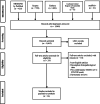Neuropathologic findings of patients with COVID-19: a systematic review
- PMID: 33483885
- PMCID: PMC7822400
- DOI: 10.1007/s10072-021-05068-7
Neuropathologic findings of patients with COVID-19: a systematic review
Abstract
Background: Despite the expanding literature that discusses insights into the clinical picture and mechanisms by which the SARS-CoV-2 virus invades the nervous system, data on the neuropathologic findings of patients who died following SARS-CoV-2 infection is limited.
Methods: A broad literature search was done for published articles that reported on histopathological findings of the brain in patients with COVID-19 in PubMed by MEDLINE, Embase, CENTRAL by the Cochrane Library, and SCOPUS from December 31, 2019 to October 31, 2020.
Results: The systematic literature search strategy used resulted in a total of 1608 articles of which 14 were included in the analysis (PROSPERO registration number: CRD42020221022). There were ten case series, two case reports, one retrospective cohort, and one prospective cohort. The age of the patients ranged between 38 and 90 years old, most of them older than 65 years old (n=66, 45.2%) and males (n=79, 54.1%). Most tested negative in SARS-CoV-2 immunohistochemistry (n=70, 47.9%). The striking pathologic changes included diffuse edema (n=25, 17.1%), gliosis with diffuse activation of microglia and astrocytes (n=52, 35.6%), infarctions involving cortical and subcortical areas of the brain (n=4, 2.7%), intracranial bleed (subarachnoid hemorrhage and punctate hemorrhages) (n=18, 12.4%), arteriosclerosis (n=43, 29.5%), hypoxic-ischemic injury (n=41, 28.1%), and signs of inflammation (n=52, 35.6%). The cause of death was attributed to the cardiorespiratory system (n=66, 45.2%).
Conclusions: The neuropathologic changes observed likely represent direct cytopathic effects and indirect effects secondary to host-specific inflammatory response induced by the viral infection. Further studies however are required to better elucidate the pathologic mechanism.
Keywords: COVID-19; Neuropathology; SARS-CoV-2.
Conflict of interest statement
The authors declare no competing interests.
Figures



Similar articles
-
COVID-19-related neuropathology and microglial activation in elderly with and without dementia.Brain Pathol. 2021 Sep;31(5):e12997. doi: 10.1111/bpa.12997. Epub 2021 Jun 18. Brain Pathol. 2021. PMID: 34145669 Free PMC article.
-
Brain autopsies of critically ill COVID-19 patients demonstrate heterogeneous profile of acute vascular injury, inflammation and age-linked chronic brain diseases.Acta Neuropathol Commun. 2022 Dec 17;10(1):186. doi: 10.1186/s40478-022-01493-7. Acta Neuropathol Commun. 2022. PMID: 36528671 Free PMC article.
-
SARS-CoV-2 and the brain: A review of the current knowledge on neuropathology in COVID-19.Brain Pathol. 2021 Nov;31(6):e13013. doi: 10.1111/bpa.13013. Epub 2021 Aug 13. Brain Pathol. 2021. PMID: 34390282 Free PMC article.
-
COVID-19 neuropathology at Columbia University Irving Medical Center/New York Presbyterian Hospital.Brain. 2021 Oct 22;144(9):2696-2708. doi: 10.1093/brain/awab148. Brain. 2021. PMID: 33856027 Free PMC article.
-
Neurological manifestations associated with SARS-CoV-2 and other coronaviruses: A narrative review for clinicians.Rev Neurol (Paris). 2021 Jan-Feb;177(1-2):51-64. doi: 10.1016/j.neurol.2020.10.001. Epub 2020 Dec 16. Rev Neurol (Paris). 2021. PMID: 33446327 Free PMC article. Review.
Cited by
-
Non-aneurysmal subarachnoid haemorrhage in COVID-19-authors' reply to Kawada T.Neuroradiology. 2021 Jun;63(6):835-836. doi: 10.1007/s00234-021-02712-z. Epub 2021 Apr 17. Neuroradiology. 2021. PMID: 33866390 Free PMC article. No abstract available.
-
Gastrointestinal Tract and Kidney Injury Pathogenesis in Post-COVID-19 Syndrome.Curr Diabetes Rev. 2024;20(4):e051023221787. doi: 10.2174/0115733998250889230919185305. Curr Diabetes Rev. 2024. PMID: 37815187 Review.
-
The Influence of Virus Infection on Microglia and Accelerated Brain Aging.Cells. 2021 Jul 20;10(7):1836. doi: 10.3390/cells10071836. Cells. 2021. PMID: 34360004 Free PMC article. Review.
-
Microglia at the blood brain barrier in health and disease.Front Cell Neurosci. 2024 Mar 13;18:1360195. doi: 10.3389/fncel.2024.1360195. eCollection 2024. Front Cell Neurosci. 2024. PMID: 38550920 Free PMC article. Review.
-
Comparison of serum neurodegenerative biomarkers among hospitalized COVID-19 patients versus non-COVID subjects with normal cognition, mild cognitive impairment, or Alzheimer's dementia.Alzheimers Dement. 2022 May;18(5):899-910. doi: 10.1002/alz.12556. Epub 2022 Jan 13. Alzheimers Dement. 2022. PMID: 35023610 Free PMC article.
References
-
- Tsivgoulis G, Palaiodimou L, Katsanos AH, Caso V, Köhrmann M, Molina C, Cordonnier C, Fischer U, Kelly P, Sharma VK, Chan AC, Zand R, Sarraj A, Schellinger PD, Voumvourakis KI, Grigoriadis N, Alexandrov AV, Tsiodras S. Neurological manifestations and implications of COVID-19 pandemic. Ther Adv Neurol Disord. 2020;13:175628642093203. doi: 10.1177/1756286420932036. - DOI - PMC - PubMed
Publication types
MeSH terms
LinkOut - more resources
Full Text Sources
Other Literature Sources
Medical
Miscellaneous

